Landings in 1942 by 5 (Coastal) Operational Training Unit
Among the many crashes and landings in Donegal during 1942, two aircraft came from the Coastal Command training unit, number 5 (Coastal) Operational Training Unit, 5 (C) OTU. This unit was based at Chivenor in January 1942 and moved to Turnberry in Scotland in May 1942. In July and October 1942, two of its aircraft would find themselves lost near Ireland and forced to landed on unknown ground.
5 (C) OTU was involved in the training of crews on Coastal Commands twin engined strike aircraft including the Bristol Beaufort and Handley Page Hampden, both of which were being used as torpedo bombers by the Command. The OTU's were designed to take aircrew who were training in their respective trades, such as pilots, navigators, gunners etc and mold them into crew teams, allowing them to train together and learn to operate as a crew before being assigned to an operational squadron.
The first of the landings took place on the 17th of July 1942 on Ballyness Strand, west of Falcarragh. The Irish Army file on this landing is very small indeed, containing all bit six sheets of paper. Among these is a hand written memo, dated 18th July 1942, recording the following:
Crash of British aircraft at Ballyness Strand near Horn Head
Co Donegal on 17.7.1942
A twin engined British aircraft crashed at Ballyness Strand 9
mls SW of Horn Head Co Donegal at approx 1915 hrs on the
17.7.1943. All four occupants escaped unhurt but the aircraft
was almost completely destroyed by fire having apparently been
set alight by the crew.
Particulars of the crew are as follows:
(1) Flight Lt. F.B. Weir (British) no 42086. Next of kin: Wife
Hamilton Arms Hotel, Girvan, Ayrshire, Scotland
(2)Flying Officer L.M. Benderey NO A5025. Next of kin: Wife
Mrs L M Benderey, Glengyle, Southpark, Avenue, Girvan,
Scotland
(3)Sergt E W Evans (New Zealander) NO NZ 411754.
Next of kin: Mr E Trigg 14 Jubilee Road, Mon, S Wales
(4)Sergt. J. McFeely (Irish) No 982440.
Next of kin Mr George McFeely, Main St, Letterkenny, Co.
Donegal
The airmen were removed to Rockhill House Letterkenny where
they were detained in military custody. They refused to give
particulars of the type of plane, station or destination.
Only one wing and one engine escaped the flames the remainder
being completely burnt out. A Browning gun with about 100
round of ammunition was salvaged and brought to Rockhill House
Letterkenny.
Min CSO [Text difficult to make out] (Major Whelan)
External Affairs to be notified.
The next paragraph dated the same date was to the effect that the crew were to be sent to Dublin via Athlone. Athlone were to be advised later in the day where exactly in Dublin they were to be brought. The following note however recorded that the 'minister' had directed that the crew were to be released. A further typed message dated 20th of August from Commandant J Power of the G2 branch, Custume Barracks, Athlone repeats the airmen's names and submits a claim for expenses incurred by by Comdt, Cunningham for the refreshment and feeding of the four men. A note at the bottom of this letter states: McFeely, who is a native of Letterkenny has since written to his father who has expressed the view that he would have much preferred if his son had been interned.
.The aircraft having suffered such damage was thus
unrecognisable to the Irish officers and no mention is made of
the fate of the small amount of wreckage. A local person however
did snap at least one photo of the wreckage. The photo
shows the front of the left hand wing, with a lot of damage, the
distinctive air intake for the oil cooler and outboard of that,
the missing cover would be over the gun camera housing, the next
port being the position of a .303 machine gun mount and the
final two openings match the position of the aircraft's landing
lights. This might point only to these parts having being
salvaged and taken away.
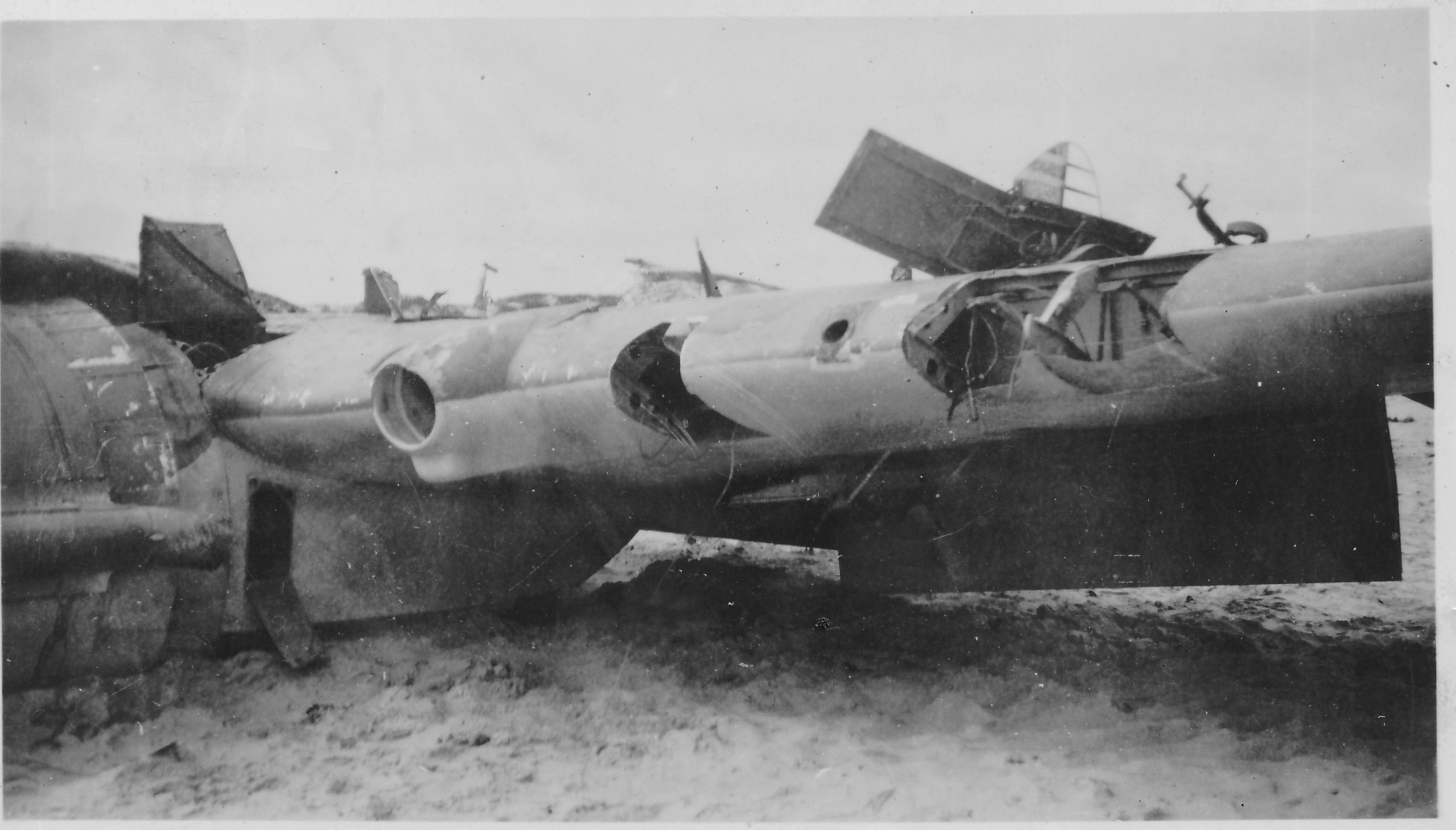
The information recorded by the Irish officers, reluctant
thought the airmen were, allowed researchers in later years to
find out more about the men. Short biographies of the men are
presented below. The identity of the aircraft is somewhat
contained in the Operations Record Book (ORB) of 5 (C)OTU as
transcribed by Margaret Morrell in 2003:
July 17 1942, 2200hrs: Beaufort N1103 reported missing. Crew:
F/Lt Weir, F/O Bendrey, Sgt. MacFeeney and Sgt Evans.
July 18 1942, 1135hrs: Phone message received from S.A.S.O.
Northern Ireland that Beaufort N1103 crashed and burnt out in
N.Ireland, all crew safe.
The aircraft serial number typed in the ORB is in error and the aircraft records indicate that it was N1003 that carried the crew to Ireland.
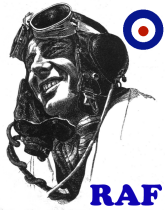
(Seeking photo) F/Lt Frederick Broadley WEIR 42086
Frederick Weir was born in Galashiels, Scotland in 1915.
Frederick Weir was an officer in the RAF as early as the summer
of 1939, being granted a short-service commission as Acting
Pilot Officer on probation. At this time it is unknown
what his service career entailed. A P/O F B Weir served
with 217 Squadron during the spring and summer of 1940 before
being posted to 417 Flight at St Athan in July 1940.
Promoted to Flight Lieutenant in 1943, he remained
at that rank until a transfer to the reserve in late 1945.
F/Lt Weir and his observer, F/Lt Bendrey are found flying
together on just two Catalina patrols with 270 Squadron in April
and May 1943. That unit was based at the time in West
Africa. No other trace of the two is found after this time
and it is assumed they were posted elsewhere in Africa or
India. Newspaper articles from October 1943 would suggset
he was possibly posted to a home station at that time as he may
have been present a friends wedding in
He was married at the time of his incident in Ireland. His
death is recorded in the Scottish death registers in 2002.
He would appear to have been a director of the J S Murray and
Company business.

F/O Leonard Marcroft BENDREY 85025 - Leonard was born on
5th April 1917 in Romford, the son of Edith and Henry
Bendrey. The 1939 Register finds Leonard resident with his
widowed mother Edith at 32 Westminster Gardens in Illford, where
his profession is listed as leading Aircraftman No 745536
R.A.F., though the last two digits area obscured. Leonard
was commissioned into the General Duties branch of the RAF as an
Observer, or Navigator, in October 1940. The ORB of 59
Squadron records the posting in on 11 Nov 1940 of: Pilot
Officer Bendrey (Air Observer), Pilot Officer Scafe and
Sergeant Taylor were posted to the Squadron from No. 2 S. of
G.R., Andover. They were attached with other crews on the
14th November to St Eval to carry out strikes against Vannes
aerodrome in France. They don't appear to have flown any
raid on that attachment but did fly a Moon 2 patrol on
the 21st Nov 1940 in Blenheim TR-M, but had to return early due
to bad weather and crashed on landing. A Moon 2 patrol is
mentioned in Forczyks
"We March Against England" as a particularly dangerous mid
channel reconnaissance patrol. They flew further
uneventful patrols on the 24th and 28th of the month with
nothing to report. He continued to fly with P/O W J Scafe
and Sgt J F J Taylor through December 1940 and into the new year
of 1941. The three were forced to bail out of Blenheim
T2040 on the night of February 23rd, 1941, returning from an
unsuccessful attempt at bombing Brest. The target could
not be located and on the return flight the wireless set went
serviceable and they elected to bail out near Tavistock.
Bendrey and Taylor suffered no ill effects but their pilot was
confined to hospital until 17 March 1941 with a knee injury and
then was sent on leave until the 23rd of the month. On the
31st March 1941, Leonard was recorded as being posted out to 31
Air Navigation School in Canada, presumably for a course of
instruction. He had not flown any operational missions in
March.
On the 2nd of June 1941, he is noted as being transferred from
No. 13 to No. 14 Specialist Course and on 11th July, is noted as
having 'ceased training' on that course. 19th July
1941 sees him posted to No 1 (M) Depot, Halifax, on completion
of course which might have seen him return to the UK that month
or in August.
We next find him with 5 OTU in the summer of 1942 and the crash
this page describes.
He was promoted to the rank of Flight Lieutenant as of the 8th
September 1942 and remained at that rank throughout the
remainder of the war.
Jumping forward about eight months then, on 9th March 1943 it
was found that a convoy escort flight by a 202 Squadron Catalina
flying boat had a F/Lt Bendrey recorded on it flying from
Gibraltar. No further mention of this officer is found in
the remainder of the month. This flight was carried out
with F/O W Gordon and F/O C G Fox, both of whom were 202
Squadron pilots. That particular ORB is not particularly
helpful for postings as non are recorded.
We next encounter F/Lt L M Bendrey at the end of April 1943 and early May 1943, alongside Frederick B Weir, as described above.
No further details of his wartime service are known at this
time.
Leonard passed away in 1975.
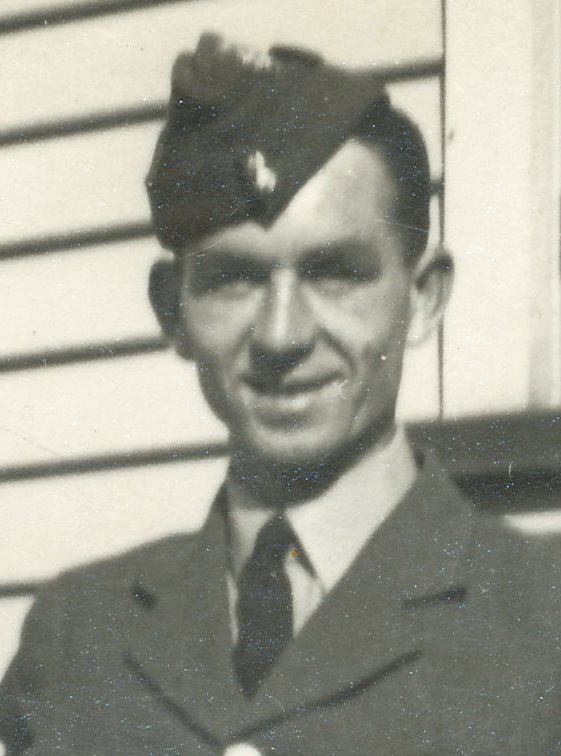
Sgt Ernest William EVANS NZ411751 Royal New Zealand
Air Force
Sgt Evans was a member of a family of seven children, born in
Wales, in October 1916. He was the son of George A Evans
and Winnifred Roberts. The family moved to New Zealand in
1919. His mother passed away in 1925 leaving Ernest and
his siblings with their father. Ernest grew up in the the
St Josephs Catholic Home, leaving school there at 15 but
remaining a resident until the time he enlisted in 1940.
His RNZAF service file includes the following summary of his
service career.
Ernest Evans was born on the 5th
October, 1916, at Newtredegar, Wales. He came to New Zealand
at an early age and was educated at St. Joseph’s Convent,
Christchurch. He played the usual sports at School and he
later played rugby. He made application for enlistment in
the R.N.Z.A.F. in November, 1938, but was unsuccessful.
After leaving school he was employed in various capacities
and at the time of his making application for aircrew
training — on the 1st April, 1940 — he was employed by the
Public Works Department, West1and.
Sergeant Evans was enlisted on
the 16th March, 1914, at the Initial Training Wing, Levin,
and, on the completion of his initial training embarked on
the 29th April, 1941, for Canada under the Empire Air
Training Scheme.
Shortly after arrival in
Canada, Sgt. Evans was posted on the 16th May, 1941, to No.
3 Wireless School, Winnipeg, Manitoba. On the 29th September
he was posted to No. 1 Bombing and Gunnery School, Jarvis,
Ontario, where — on the 25th October, 1941 — he was awarded
his wireless operator air gunners’s badge and promoted to
the rank of Sergeant. He embarked on the 3rd November, 1914,
from No. I “Y” Depot, Halifax, Nova Scotia, for the United
Kingdom.
Sgt. Evans arrived at No. 3
Personnel Reception Center, Bournemouth, on the 14th
November 1941, and was posted on the 3rd December to No. 1
Signals School, Cranwell, Lincolnshire. On the 4th
March, 1942, he proceeded to No. 3 Radio School, Prestwick,
Scotland. Early in June he was posted to No. 5
Opeartional Training Unit, Chivenor, Devon, where he
trainined on Anson, Hapden and eaufort aircraft. On
the 17th July 1942, St. Evans was a member of a beaufort
aircraft engaged on a navigational exercise which crashed in
County Donegal, Eire. The crew were first reported
safe and were classified as missing, believed
interned. In August 1942, Sgt Evans returned to his
unit. On the 1st September he was posted to the
Torpedo Training Unit, Abbotsinch, Scotland. From this
base, as wireless operator air gunner of Hampden aircraft,
he trained in conjunction with the Royal Navy.
On the 12th October, 1942, Sgt Evans
was the W/O A/G of a Hampden aircraft which flew in the sea
while carrying out practice night torpedo attacks on a
target ship of the Firth of Clyde, Scotland, His body
was not recovered and he was classified as missing, believed
killed. In due course, his death was officially
presumed to have occurred on the 12th October 1942.
Sgt Evans name is recorded on the Runnymede Memorial of the missing. His brother, Leslie, served as a Private in the New Zealand Expeditionary Force and was wounded during 1943.
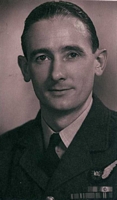
Sgt James MACFEELEY 982440 was unique among the many
airmen who landed in Ireland during the war as he was in fact
from the 26 counties of neutral Ireland.
Jim MacFeeley came from Letterkenny, Donegal and the the story
of his father expressing his wishes that his son had been
interned have entered into the history books. His nephew
was kind enough to make contact and provided a copy of his post
war log book which details flying up to 1952.
It is not known where he carried out his early training as a
wireless operator and air gunner, but after his time with 5 (C)
OTU, he was posted to 455 Squadron of the R.A.A.F. based
in After his time with P/O Cliff's crew in 455 Squadron,
Jim was posted out to 6 (C) OTU as the Squadron was
transitioning from the four seat Hampden to the two seat
Beaufighter. This posting took place on the 7th Jan 1944. After
his posting to 6 (C) OTU he flew with 117 Squadron in Burma, a
unit performing transport duties with the Dakota aircraft. Jim's
nephew was able to provide details of his later flying log book,
Jim having gone on to serve after the war with the RAF also. In
late 1949 he was flying as a signaler with 4 Radio School at
Swanton Morley. His final service may have been in 1952 with 230
Operational Conversion Unit, flying gas signaler on Lincoln
bombers.
He may have lost contact with his family in Ireland as it is
unclear when he passed away.
=================================================================================
The second visit of a 5 (C) OTU aircraft to our shores occurred on the 29th October 1942. This time the aircraft was destroyed in the landing as a result of hitting obstacles on the ground. It crashed in the townland of Edenmore near Ballybofey in land described as of 'Mr Corcoran's Estates' by the Irish Army. The Irish army records describe what witnesses reported, that the aircraft had tried to land in a field but could not stop, crashing through two hedges, breaking a telephone line pole and finally coming to rest on a stack of potatoes. The aircraft had a crew of three and they suffered minor injuries. The crew of this aircraft, Hampden P1284 were:
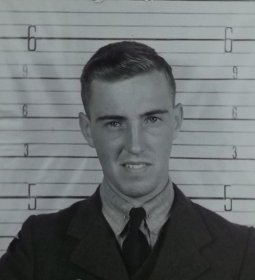
W/O Donald MONTGOMERY R/101199 RCAF - Donald was born in
December 1922 in Vancouver, British Columbia (B.C.). His parents
were Hazel and William Montgomery. His father had been born in
Scotland and his mother was British Columbian. He attended
schools in B.C. and his address at enlistment was New
Westminister, B.C. He enlisted on December 28th, 1940, the
day of his 18th birthday.
He commenced his service in May 1941, being assigned to
Penhold airfield, Alberta. He progressed through his flight
training at various units in Canada and obtained his Pilots
Flying badge in January 1942 with 15 Service Flying Training
School (SFTS), Claresholm, Alberta. He had been given
embarkation leave earlier that month and was embarked for the
United Kingdom almost immediately and arrived in England in late
January 1942.
Upon arrival in Europe, he was assigned to 14 (Pilots) Advanced
Flying Unit ((P)AFU) at Ossington in Nottinghamshire. Here he
would have been instructed in the finer points of flying in the
poor weather and busy skies of England. His next posting brought
him to RAF Turnberry in Scotland and 5 (C) OTU in August 1942.
In September he had an unfortunate incident upon landing in
Hampden P1312 when he accidentally retracted his landing gear
and ended up damaging the aircraft. October would find him
crashing in Ireland as described above. These set backs aside,
he was posted finally to 415 RCAF Squadron in March 1943. By
this stage he had been promoted to the rank of temporary Warrant
Officer, 2nd Grade. He posted in with J D Scott at the same
time, J C McGhee having been posted earlier to 455 Squadron
RAAF.
Sadly, luck ran out for Donald and John Scott on a training mission on the 3rd April 1943. They were part of the same crew of a Hampden, serial number L4084, that dived into the ground in the vicinity of Marsh Farm, Sussex. The crew had been involved in a fighter affiliation exercise with a pair of Hawker Typhoons, when after evasive maneuvering, Flight Sergeant Montgomery lost control of the Hampden. The aircraft went into a spin at 2,000 feet from which it unfortunately did not recover. He is buried alongside Sgt Scott and the remaining two members of the crew, WO2 William James MACKAY and F/S John William WHIPPLE in Littlehampton Cemetery, Sussex. His headstone is presented on the findagrave.com website and his local community remember him on the Chilliwack Museum and Archives website. On November 11, 1993 the British Columbia Government named a ridge to honor RCAF Warrant Officer Donald Montgomery, R101199. The website of 415 Squadron provide a link to information on this location:- Montgomery Ridge
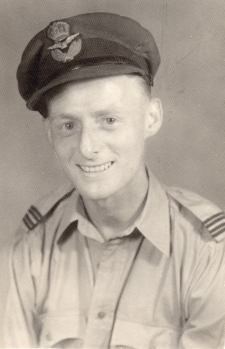
P/O John Costello MCGHEE 121251 gave his address to the Irish Army as Hallhill Road in Glasgow. It was possible to identify his correct name using telephone directories. P/O McGhee continued to serve in the air force and in went on to serve with Sgt James McFeeley, the Irish airman who was on Beaufort N1003, described above. He rose to the rank of Flight Lieutenant by 1945. His records show that he was attached to No. 5 (C) O.T.U. / No.1 T.T.O. at Turnberry from 20-Aug-42 until 4-Mar-43. After that he joined No 455 R.A.A.F. Squadron at Leuchars from 13-Mar-43 to 2-Jan-44. There he flew in the Hampden bomber in the torpedo attack role under the crew of Sergeant Sidney John Cliff 656377. Sgt Cliff was later commissioned an officer with serial number 156701. The remainder of the crew were Sgt McFeeley as mentioned above and a Canadian airman, Sgt D H McLean R/92022. While there they were involved in a incident with Hampden AT169 on November 5th 1943. They took off from Leuchars with an anti-shipping strike package of three aircraft escorted by two Beaufigthers of another Squadron. Bad weather forced the formation to turn back and all aircraft landed at the base at Fraserburgh. P/O Cliff landed before the airfields flare path was lit and he overshot the runway, badly damaging the aircraft. They were back in action again on November 11th, 19443. His next posting was No. 131 (C) O.T.U. at Killadeas from 7-Jan-44. In April 1945 he transferred to Camp Kilmer, U.S.A. then No. 111 (C) O.T.U. in Nassau. From there he was involved in the ferrying of Liberator bombers to India. He was discharged from the RAF on 23-5-46.
He passed away in 2000 in Falkirk aged 79.
His son was able to provide this photo of John alongside of Sgt
Montgomery. It is not dated but must have been taken at
Turnberry during their time at 5 (C) OTU.
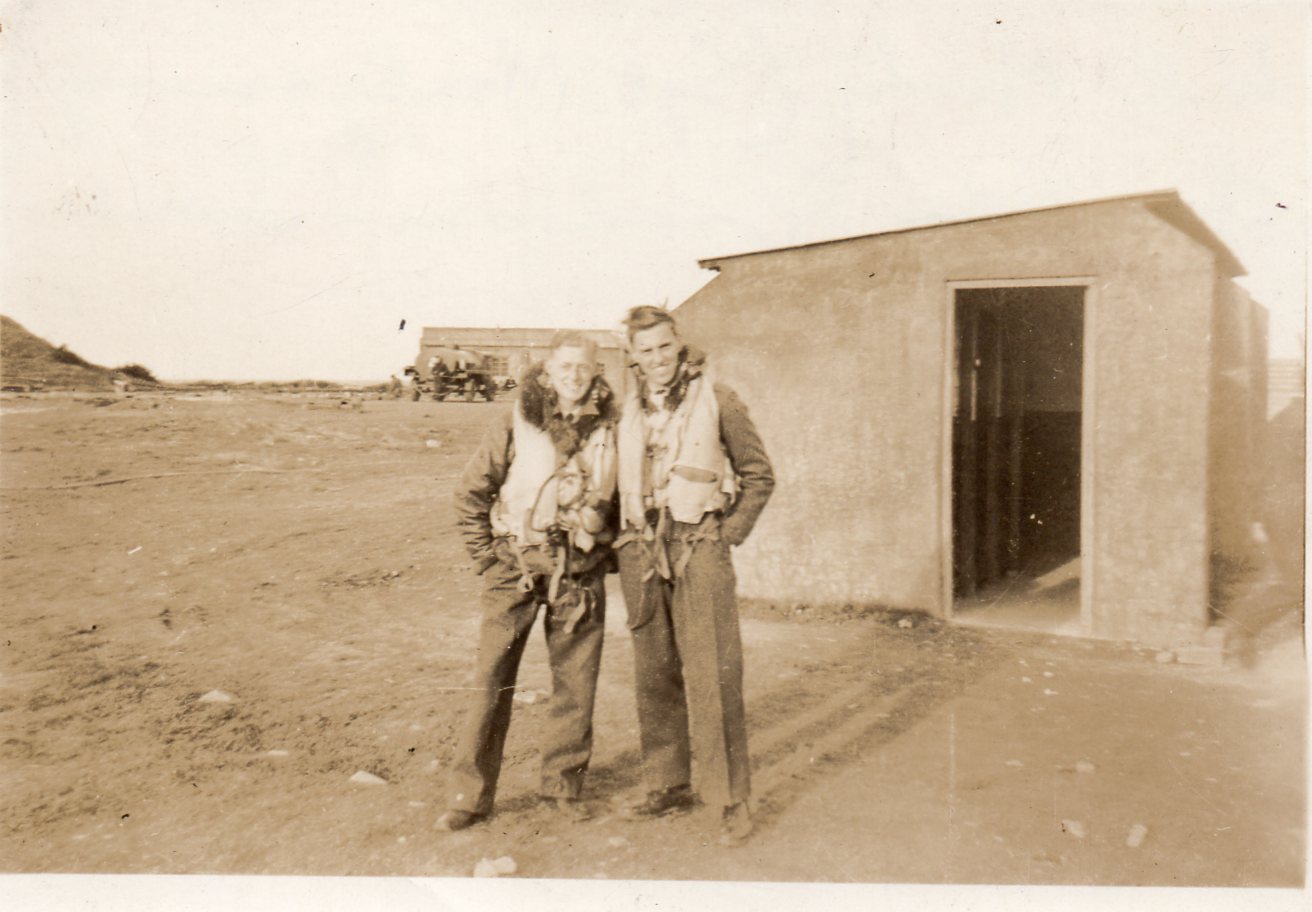
Sgt John Douglas SCOTT R/98256 DIS RCAF - Sgt Scott
came from Windsor, Ontario, son of Bessie and Robert Scott, His
father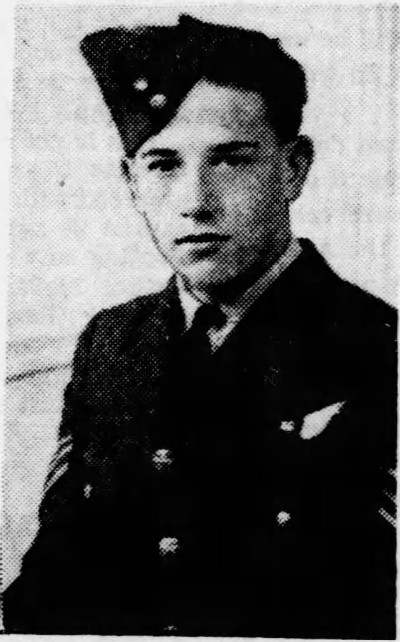 , like Donald
Montgomery's father, came from Scotland, his mother being
American. His date of birth was 31 December 1922, being almost
exactly the same age as his pilot. He enlisted in May 1941 in
Windsor and progressed through his training in Canada until he
was awarded his Air Gunners Badge at 1 Bombing and Gunnery
School (B&GS) it Jarvis, Ontario. His name was published in
the Globe and Mail newspaper on the 13 of April, 1942 alongside
those of his class members, the newspaper reporting as follows:
, like Donald
Montgomery's father, came from Scotland, his mother being
American. His date of birth was 31 December 1922, being almost
exactly the same age as his pilot. He enlisted in May 1941 in
Windsor and progressed through his training in Canada until he
was awarded his Air Gunners Badge at 1 Bombing and Gunnery
School (B&GS) it Jarvis, Ontario. His name was published in
the Globe and Mail newspaper on the 13 of April, 1942 alongside
those of his class members, the newspaper reporting as follows:
Jarvis Airmen Graduate: Brantford, April 12 (Special) .-
"Getting wings is a turning point in your flying career. If
you apply yourself in action as well as you have in your
training here, then you will acquit yourselves well," Squadron
Leader L. S. Brooks, acting officer commanding No. 1 Bombing
and Gunnery School, R.C .A .F ., at Jarvis, told classes of
observers and gunners who graduated on Saturday
afternoon.
He was embarked for the UK that month, and was assigned
after a time to No. 4 Radio School at RAF Madley, in
Hertfordshire. July 1942 seen him posted to No. 3 Radio
Direction Finding School at Prestwick, and thereafter to 5 (C)
OTU. He followed with Sgt Montgomery to 415 Squadron in
March 1943 where, as described above, they met their deaths just
weeks after arrival.
The young airman received an official admonishment in the
aftermath of the crash of Hampden P1284, having been
found: Hazarding the safety of and contributing to
damaging His Majesty's Aircraft Hampden P1284 in that by
negligence he failed to diagnose and correct a fault in the
wireless equipment early enough to prevent complete W/T
failure.
Both Montgomery and Scott were buried side by side on April 7th
1943. John Scott was just 20 years and 3 months old.
John Costellos son was further able to provide the following
group photos containing his father. Sadly no other names
or dates are recorded.
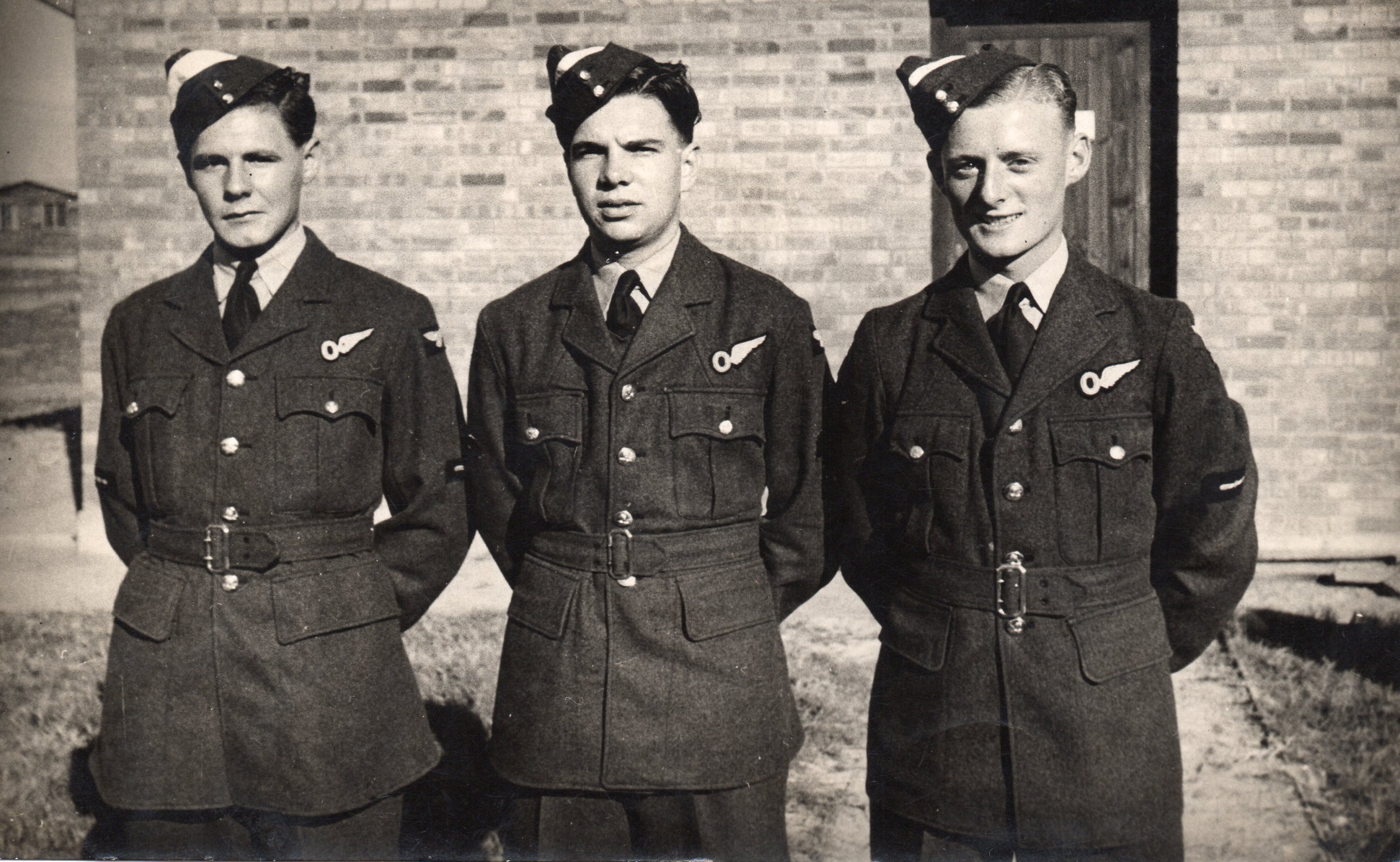
John C McGhee is on the right of this image above.
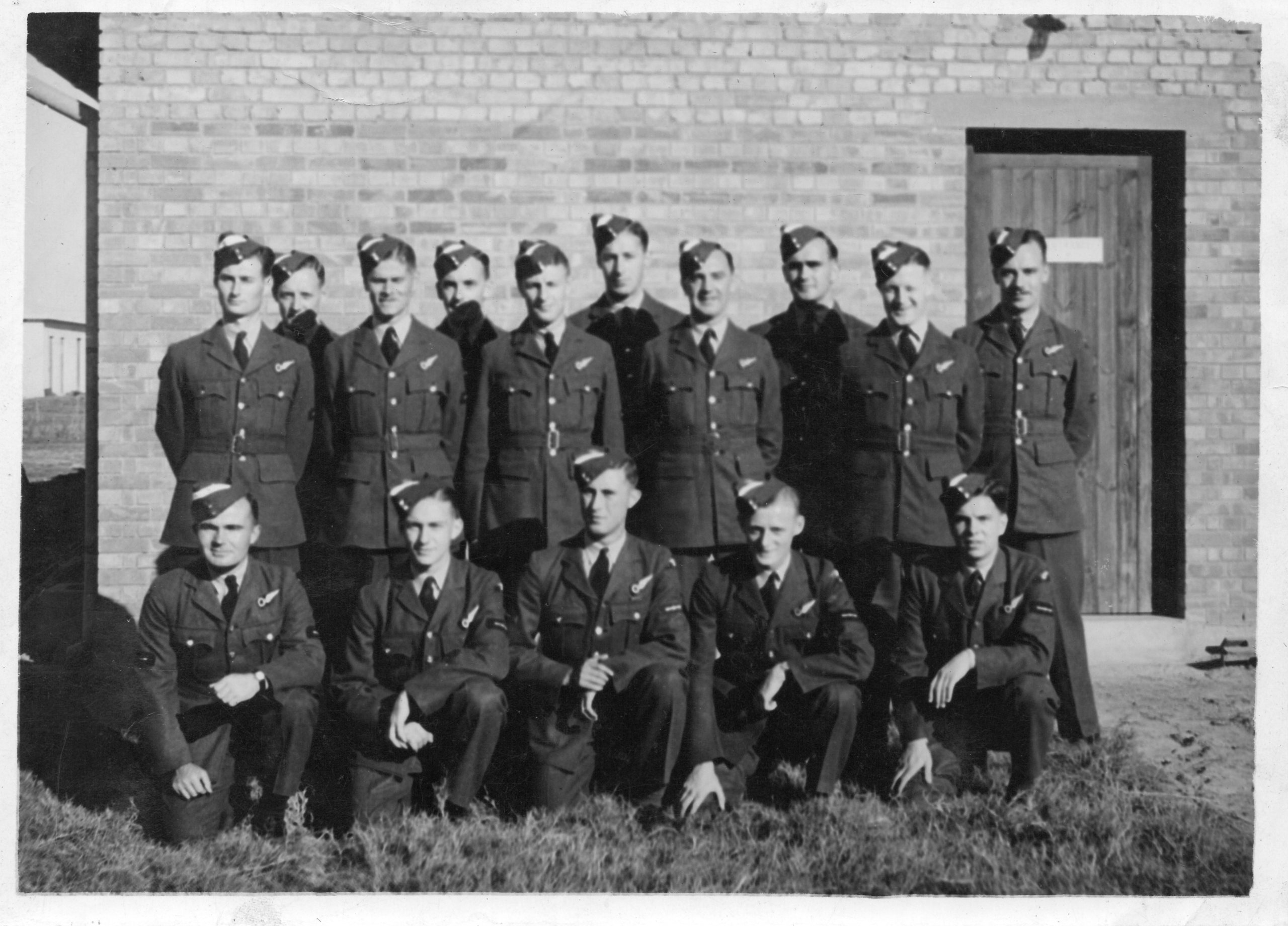
Group of 15 airmen, John C McGhee can be seen in front row, 2nd
from right. Do you recognize any of the men in the
above photo?
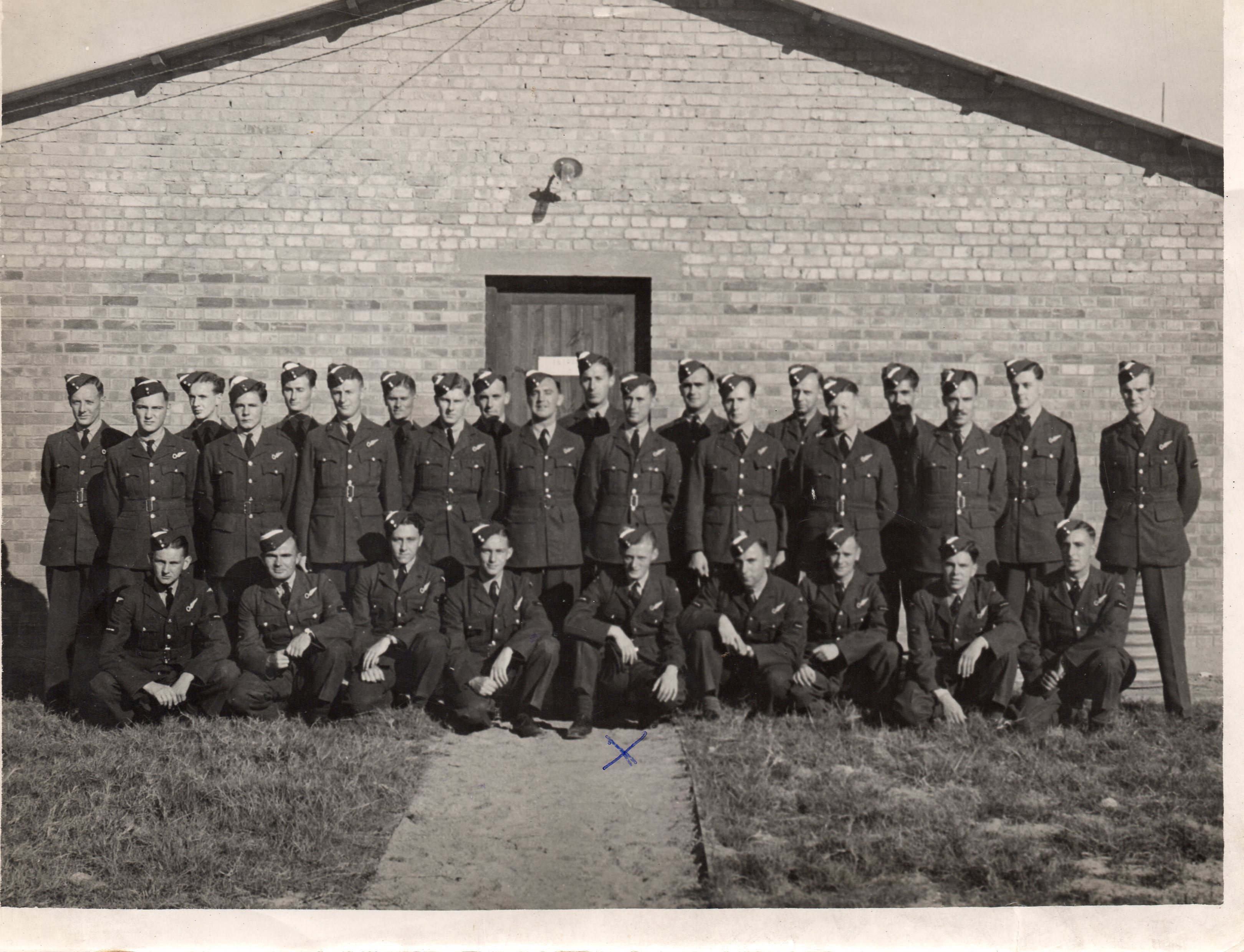
A group of 29 observer (navigator) trainees. John
Costello is indicated by the X marked on the photo. This
and the 6 and 15 man photos above are all taken at the same
location, and given that each man wears his observer breast
badge, it might have been taken on the day they graduated from
their training establishment prior to Operational Training
Unit. None of the men appear to be wearing any stripes as
non commissioned officers (NCO).
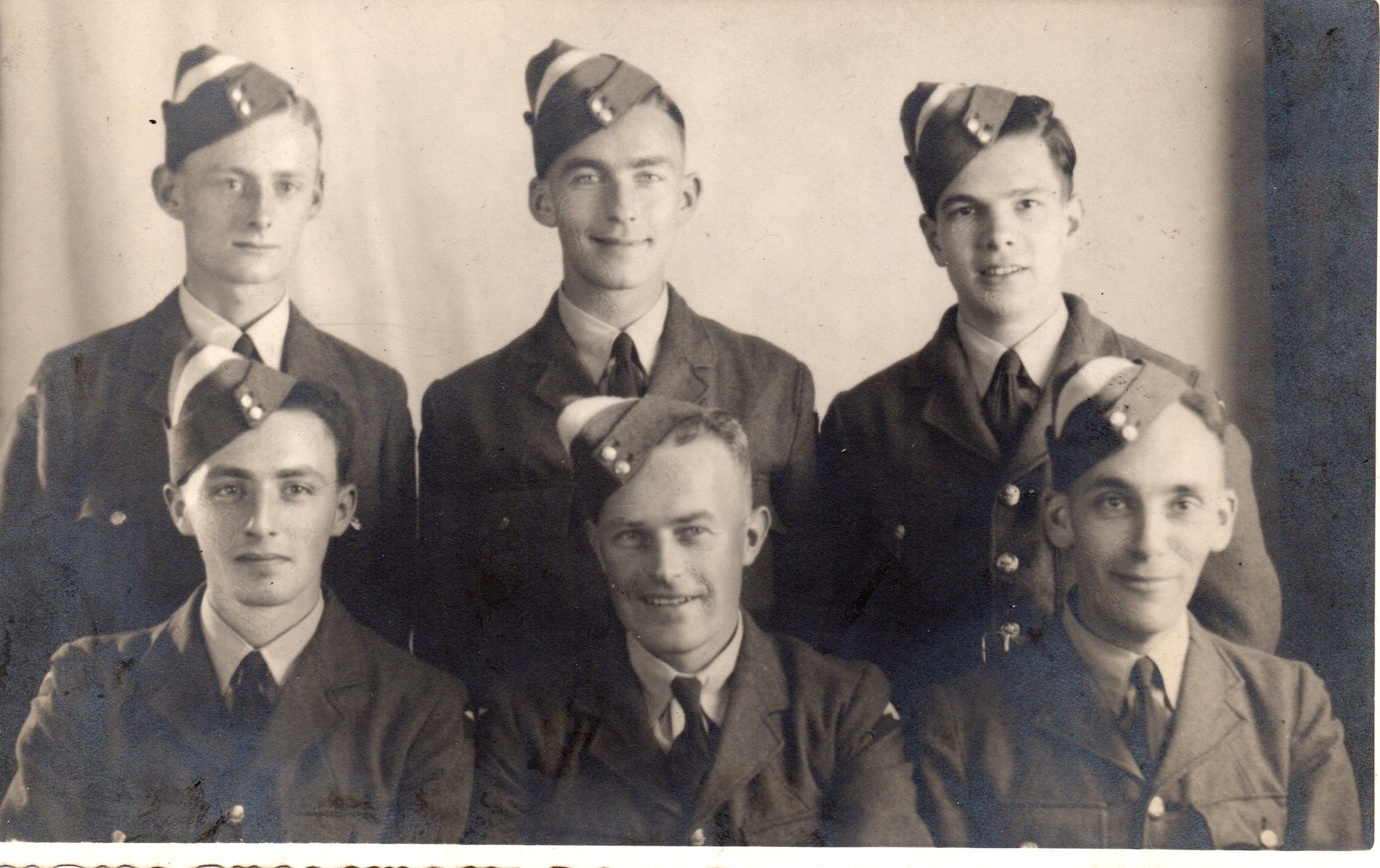
The above photo, with John McGhee standing at the rear left,
shows six airmen and would appear to be taken prior to the
photos above.
Compiled by Dennis Burke, 2016, Dublin and Sligo.
